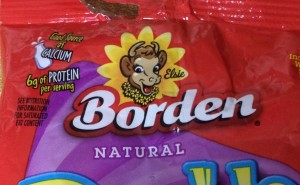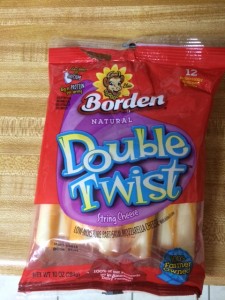For this assignment I chose to analyze a Borden cheese stick package, which features an anthropomorphic cow logo on the front of packaging. The cow in the logo is smiling and wearing a necklace mad of daisies, which I believe is supposed to suggest that Borden only uses happy cows to make their cheese and dairy products. There is also a sun shining and bright, upbeat colors surrounding the cow, which insinuates that the farms that Borden raises the cows on are nurturing, natural environments where cows have access to sun light and other necessary amenities. The package also features the name “Elsie” next to the cow, which serves to humanize her and make it seem as though the farmers who raise these cows form personal relationships with their livestock and view them as unique individuals with intrinsic value.
If you were to view the anthropomorphic cow on the package with regards to Foer’s idea of species barrier it would become increasingly apparent that this cow symbol represents the large species barrier that exists within our current food system. In the Words/Meanings section of “Eating Animals” Foer discusses a phenomenon in which humans find themselves drawn to one particular animal while completely disregarding the wellbeing of another smiliar animal. The example that Foer provides focuses on a zoo in Berlin that brought in hundreds of guests by having a cute polar bear named Knut, yet they fed those same animal lovers Wurst de Knut, which was a pork product made entirely from factory farmed pigs. This inability to care for the wellbeing of all species across the board is especially evident through the advertisement of many animal byproducts. If I were to go into the grocery store and look in the milk section I’d most likely find dozens of cartons and dairy products featuring happy cows on the label, and might even pick one brand over another if one mascot really pulls at my heart strings. This is because species barrier had led me to sympathize with the cute, anthropomorphic version of a cow and disregard the wellbeing of the actual cow that was milked and used for it’s by products. The species barrier causes humans to value one animal, or in this case representation of an animal, over another because that particular animal has a greater usefulness or appeal than another. This is a flawed system because it creates a false dualism that exists just to sell products. These products are marketed to manipulate people’s emotions and in doing so they fail to actually get people interested in the wellbeing of the animals that are being depicted. This is not an issue if the farmers genuinely practice family farming techniques, but if the company marketing these products engages in factory farming practices then this is incredibly misleading and wrong because their cows are definitely not happy in the conditions they’ve placed them in.
Borden’s depiction of cows on their packaging also embodies the new type of Anthropomorphism that Berger discusses in “Why Look at Animals?” when he says, “Anthropomorphism was the residue of the continuous use of animal metaphor. In the last two centuries, animals have gradually disappeared. Today we live without them” (Berger 11). Berger’s ideas on anthropomorphism are important because they help to reveal that anthropomorphism has historically been used to describe the human condition through animal metaphors, but the growing need for animal by-products in last two centuries have led us to lose our connection with these creatures and in turn reduce them to “the model of a machine”. This explains why Borden uses “happy cows” on their packages because it comforts the consumer by making them think they’re supporting a brand that still views animals anthropomorphically, when in reality Borden is just using happy, anthropomorphic depictions of these animals to sell more products. The anthropomorphizing of animals on food packaging is really just an attempt to suggest that the animals are happy to be used for their meat and by-products and are raised in acceptable conditions.


Is your article saying that an image of a “happy cow” is related to viewing the cow anthropomorphically? I was confused about that part because my image that I posted of a sour cream container features a cow that appears to be happy but is not being anthropomorphized.
Yes I was trying to say that companies create the idea of a happy cow when they create anthropomorphized animals as their logos because obviously factory farmed cows are not happy to be used for the sole purpose of being milked all their lives. In my essay I will articulate this better by discussing how the technique of using anthropomorphized animal logos is specifically troublesome when used by factory farm based companies because they are creating a facade that their animals are happy when in reality it’s likely they’re miserable because they’re living in unsanitary conditions are being genetically manipulated to yield more milk than usual.